- Joined
- Jul 5, 2008
- Location
- CFL
Isn't Sandy-E = Ivybridge?
I'm confused now...
I'm confused now...
Welcome to Overclockers Forums! Join us to reply in threads, receive reduced ads, and to customize your site experience!
On top of this, we're hearing that although the rated TDP is 130W these beasts are consuming closer to 180W and that's without even overclocking them. In fact, according to PSU design guidance we've seen, Intel is telling power supply makers to make sure their Sandy Bridge-E PSUs can cope with a peak current of 23A on the 12V2 rail and based on an 80 percent or better efficiency rating of the PSU.
Read more: http://vr-zone.com/articles/exclusive-sandy-bridge-e-to-ship-without-cooler/13296.html#ixzz1V8EutlPc


Yesterday Evilsizer posted about Sandy Bridge-E to ship without cooler......In that link was
This may very well turn out to be true............But at this point
View attachment 98505
Sounds alittle fishy to me..........time will tell i guess.
 Maybe switch out the GTX460 with the GTX260 so's I don't slow down my 2600K when the time comes and I GPU fold for some heat come fall as I have electric baseboards. Winning!
Maybe switch out the GTX460 with the GTX260 so's I don't slow down my 2600K when the time comes and I GPU fold for some heat come fall as I have electric baseboards. Winning!This is slightly embarrassing, but we have to start by apologizing here, as we got some information mixed up, but then again, no-one else spotted it either so there you go. It turns out that Intel's X79 chipset will have a total of 10 SATA ports after all, although there still won't be any SAS support.
The mistake came to light when looking at a couple of slides from an updated presentation detailing Intel's Patsburg chipset, as the -A version of chipset will have an additional four SATA ports via the SCU. This was an oversight on our side and if you remember the chipset diagram that we've already posted a couple of times, it's even listed as a feature on there.
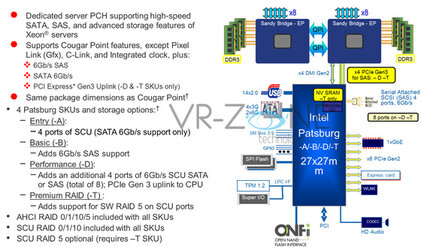
So what we're looking at is four SATA 3Gbps ports and two SATA 6Gbps ports which are part of Intel's standard AHCI setup as per the current 6-series chipsets. The other four ports are added via the SCU, but unlike early details of the X79 chipset suggested, we're not getting any SAS support and we're still four ports short. One major difference between the X79 as well as the -A version of the Patsburg chipset compared to the higher-end versions (-B/-D/-T) is that there will be support for RAID 5 for the SCU ports, something that's an optional feature on the higher-end SKUs. Note that it's not possible to run a RAID between the SCU and AHCI ports at BIOS/UEFI level, although it should be possible to stripe drives across the controllers in the OS.
Once again, apologies for this little snafu, especially as the information was right in front of us. To make up for things a little bit, we've also gotten word that Intel's will be bringing out a new stepping of the Patsburg chipset in late Q4, as there are still a few kinks to work out in the versions beyond the -A SKU. The company is also actively working on validating PCI Express 3.0 support in the platform, but there's no word as to when we'll see actual support. Once all of this has been done, we might, with a bit of luck, finally see a version of the X79 chipset that delivers everything that was promised, well, ok, it wasn't really promised, but it was part of what people expected to get from the X79 chipset based on various roadmap leaks.
Read more: http://vr-zone.com/articles/x79-to-have-10-sata-ports-after-all/13317.html#ixzz1VGM5PLPH
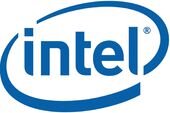
Despite all the troubles Intel has had with Sandy Bridge-E and the X79 chipset, DonanimHaber reports that it is set to release as early as November. The Platform Launch is specified as Weeks 46-47, which covers November 14th to November 27th. However DonanimHaber inisist that the final release date is November 15th.
The three SKUs are Core i7 3820, Core i7 3930K and Core i7 3960X, priced at $294, $583 and $999 respectively. The new flagship, Core i7 3960X, is expected to be 15% faster than the Core i7 990X on average. However, the 3960X is much faster in applications that rely heavily on memory bandwidth (thanks to X79's quad-channel memory) or AVX.
Meanwhile, AMD's Bulldozer continues to slip. What was once expected to be a 2 quarters lead with Bulldozer expected to release in June and Sandy Bridge-E in end 2011, is now likely to be a couple of months, at most.
Read more: http://vr-zone.com/articles/report-intel-sandy-bridge-e-on-november-15th/13522.html#ixzz1XNu1IXdh
Intel Corp.'s next-generation Core i7 "Sandy Bridge-E" microprocessors for performance enthusiasts will deliver from 12% to 65% higher performance compared to current extreme chips, according to estimates by the manufacturer. Thanks to Sandy Bridge micro-architecture and other improvements, the new chips will offer tangible performance boosts compared to existing offerings from Intel.
According to a document with Intel's performance estimates of the Core i7-3960X processor (six cores, 3.30GHz, 15MB cache) seen by X-bit labs, the forthcoming chip for the LGA2011 platform is clearly faster than its predecessor Core i7-990X (six cores, 3.46GHz, 12MB cache) across a range of benchmarks despite of lower clock-speed amid the same amount of cores due to advantages of the Sandy Bridge micro-architecture over Nehalem/Westmere micro-architecture, quad-channel memory controller and other innovations.
Well with a 15 NOV release date, it will come out in time for Black Friday. Wonder what kind of crazy deals will pop up over these... That is is any stock left by then.
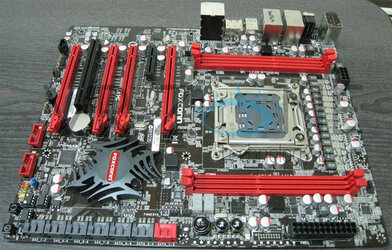
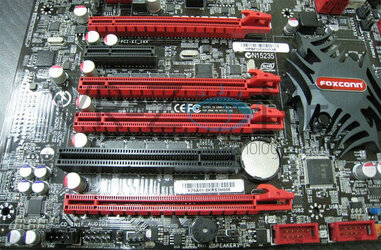
Having first made waves at this year's Computex, it's time for Foxconn's premium socket LGA2011 motherboard, the Quantum Force X79, to get down to business. The channel brand of the OEM giant is gearing up for a Q4 2011 launch, and seems to have made some notable changes to the design we saw in June, on its latest engineering sample. These changes include rearrangement of expansion slots, a finalized design for the heatsink over the X79 chipset, and a slight rearrangement of the front-panel header area. While this is still an engineering sample, there is some progress - for better or worse - as the final release revision takes shape.
The Quantum Force X79 is positioned to be a high-end socket LGA2011 motherboard. The processor is powered by a 14-phase VRM that makes use of DirectFET MOSFETs, which when backed by a good I2C-capable VRM controller have known to provide smooth voltage control. Such FETs have been used on older Quantum Force motherboards and BIOSTAR's TPower series models. Other overclocker-friendly features include redundant firmware (BIOS), consolidated voltage measurement points, and OC hard-tuning buttons apart from power and reset buttons.
Read more: http://vr-zone.com/articles/foxconn-quantum-force-x79-new-version-pictured/13543.html#ixzz1Xpu21oht
I think the older Sandy Bridge cpus will be slashed even more than the newer ones on Black Friday...
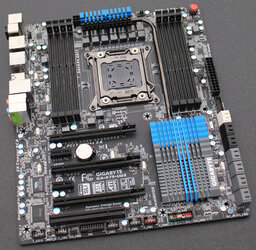
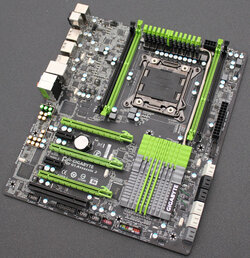
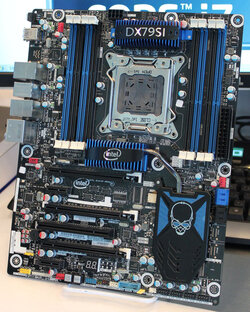
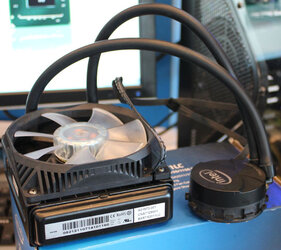
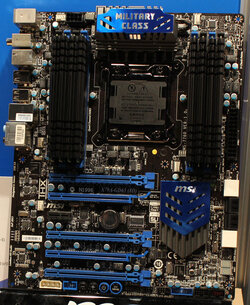
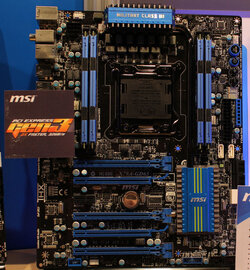
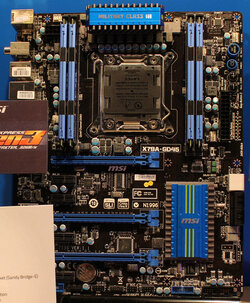
Intel isn't having a good year when it comes to its integrated controllers this year, first with the SATA 3Gbps issue in the 6-series chipset and now news has reached us that in the end we won't be seeing any additional SAS/SATA ports in the X79 chipset. Apparently this is because of a “quality issue” in the SCU which would've been home to the four additional SAS/SATA ports.
We're not sure what the exact problem is, but combine this with rumours of a delay of Intel's Sandy Bridge-EP server parts and it seems like the SCU issue might be affecting the server and workstation parts as well. That said, we've also spoken to motherboard manufacturers that told us that they haven't been able to replicate Intel's errata, so it remains to see what happens, as we're still about two months away from the official launch.
It has to be said that Intel's X79 chipset has gone from being a chipset packed with features to the brim, to a chipset that is starting to look very much like the current P67 chipset, something that surely must be disappointing not only for Intel's partners, but even more so for those who were/are planning to buying into the new platform. By now we've gone from eight, to four to no SAS ports and what we're left with is two SATA 6Gbps ports and four SATA 3Gbps ports.
We're afraid that the bad news doesn't end there though, as Intel won't even guarantee PCI Express 3.0 compliance for the Waimea Bay platform with the company claiming that the first generation of Sandy Bridge-E processor might not be able to cope with the high speed of the PCI Express 3.0 interface. In other words, it'll be a bit of a hit and miss as to which PCI Express 3.0 add-in cards will actually work with the first Sandy Bridge-E processors.
And if you were hoping for Ivy Bridge-E to sort this out next year, well, then we have really bad news, as Ivy Bridge-E isn't schedule to arrive until 2013 now. On the upside, Intel expects Ivy Bridge-E to be fully compatible with PCI Express 3.0. While on the subject, we've also managed to confirm that the delay of the quad core Core i7 3820 means that it's unlikely to arrive this year, as it'll only go into production at the very end of 2011. Can it possibly get any worse for Intel?
Read more: http://vr-zone.com/articles/what-in...andy-bridge-e-at-idf/13552.html#ixzz1XvqgIpPp
Final Remarks
Everything we saw this week that was related to the upcoming LGA 20111 platform proves that it is going to launch very shortly. The mainboard makers suspect that at this time the launch is planned for some time in mid November, but Intel may push this important even to an earlier date just as easily. So, AMD Bulldozer processors won’t be enjoying their leadership for long: they should soon face a very serious opponent.
Last week some details on how to overclock Intel's upcoming Sandy Bridge-E CPU were posted over at bit-tech and in as much as it covered the basics, details from a Taiwanese website that leaked almost simultaneously puts all of the puzzles pieces together. If and that's is a big if, someone can hit Intel's theoretical maximum clock speed for the upcoming Sandy Bridge-E processors, then we can expect to see CPU running at a massive 9.5GHz.
So far only details of the turbo frequency for the Sandy Bridge-E processor have leaked, but with the help of all the additional details, we finally have a clearer picture of what to expect. It seems like Intel decided to drop at least one or two of the multipliers we heard were available on early engineering samples of the Sandy Bridge-E CPUs and as such we're stuck with 1.25 and 1.67, although just like with the current Sandy Bridge processors, the BCLK can be adjusted in increments of 1MHz.
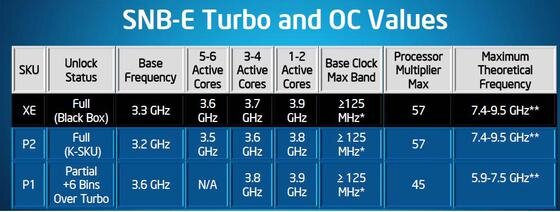
One slight snag is that we're stuck with the same 57x multiplier limit that we see on the current Sandy Bridge CPUs, although this does of course only apply to the 3960X and the 3930K, as the quad core 3820 is limited to a 45x multiplier. As things go, the 3820 can be overclocked six bins over its top Turbo multiplier which is 39x, although if Intel's "coarse" BCLK multipliers work as intended, it looks like speeds of a lot more than 4.5GHz can be achieved even here, with Intel hinting at speeds of between 5.9 and 7.5GHz. Not bad for a CPU which is expected to retail for US$294 in quantities of 1,000
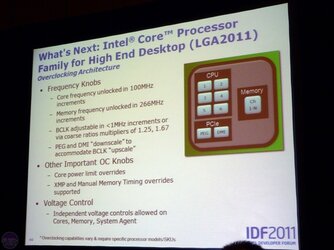
Also, if it should matter to ya, Sandy Bridge-E will launch on the 14th of November, not the 15th